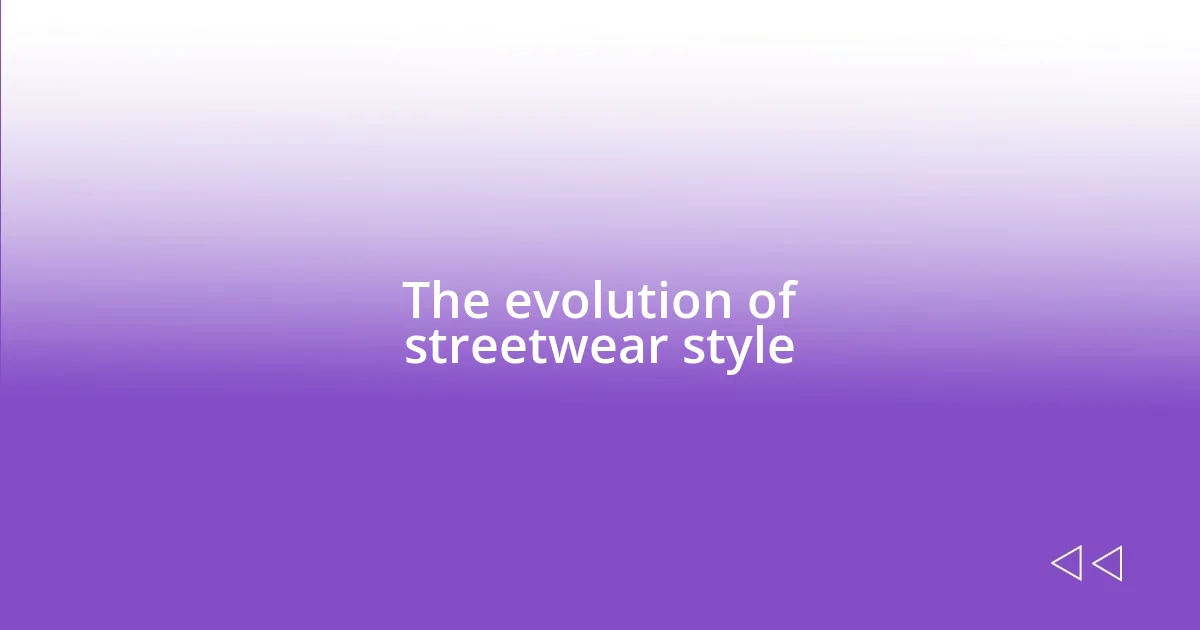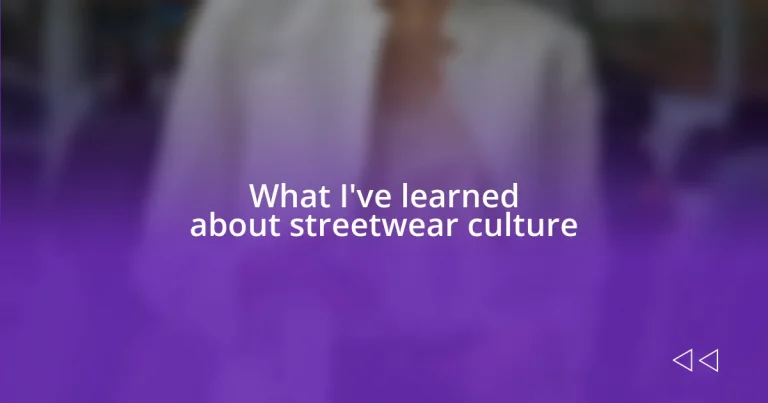Key takeaways:
- Streetwear culture is rooted in youth rebellion and self-expression, influenced by skateboarding, hip-hop, and punk, symbolizing individuality and community.
- The evolution of streetwear has transitioned from niche origins to mainstream luxury, shaped significantly by social media which democratizes fashion and fosters community engagement.
- Key brands like Supreme, Off-White, and BAPE have defined modern streetwear, each contributing to the narrative and identity within the culture.

Understanding streetwear culture
Understanding streetwear culture requires an appreciation of its roots in youth rebellion and self-expression. I remember my first encounter with streetwear – it was a cool Friday evening at a local pop-up shop, buzzing with energy. The way people wore their clothes spoke volumes; it was a visual language that screamed individuality and defiance, while also creating a sense of community. Have you ever felt that rush of connection with others over a shared style?
At its core, streetwear is more than just fashion; it’s a movement born from global influences like skateboarding, hip-hop, and even punk culture. When I first started exploring different brands, I realized that each piece had a story behind it, reflecting the artist’s or designer’s vision. It’s fascinating how a simple hoodie could symbolize freedom and creativity, don’t you think?
Moreover, streetwear thrives on collaboration and innovation, often merging high fashion with everyday clothing. I’ve seen collaborations that surprised me, merging unexpected brands and creating trends that felt both fresh and nostalgic. The culture evolves so rapidly that, at times, it feels like you have to keep up or miss out. Isn’t it exciting to think about how each new drop could redefine what’s “in”?

Key influences on streetwear
Streetwear culture is a melting pot of influences that speak to various aspects of urban life. For me, the creativity inspired by skateboarding was particularly striking. I recall a day at a skate park watching skaters showcase their skills while rocking unique outfits that blended practicality with style. It was a vivid representation of how streetwear evolves from action and attitude, influencing not just what we wear, but how we express our identity.
Key influences on streetwear include:
- Skate Culture: Originating from skateboarding, this influence brings an edgy, rebellious spirit to streetwear.
- Hip-Hop: The music genre has shaped aesthetics and attitudes, often incorporating bold graphics and statement pieces.
- Punk: Influencing DIY fashion and anti-establishment messaging, punk adds a layer of authenticity and edge.
- Art and Graffiti: Street art’s vibrant colors and messages translate into fashion, echoing the artistic expression found in urban landscapes.
- Sportswear: Athleisure has blurred the lines between streetwear and sports, promoting comfort without compromising style.
Reflecting on these influences, I always find it incredible how streetwear acts as a canvas for individuals to showcase their interests and backgrounds. Whether I’m flipping through a magazine or scrolling on Instagram, each piece I encounter tells a story, connecting me to the culture in a way that feels deeply personal.

The evolution of streetwear style
Streetwear style has undergone an incredible transformation since its inception. I remember my high school days when oversized tees and baggy jeans were all the rage. Designers started to take notice, and streetwear began to capture mainstream attention, evolving dramatically from being just for skaters and hip-hop fans to influencing luxury runway shows. This shift made me think about how fashion can be cyclical—what was once considered niche has been embraced by high fashion, leading to a fusion that feels both innovative and reflective of its roots.
Fast forward to today, and you can see streetwear reflecting diverse influences from music, art, and global cultures. I often find myself drawn to collaborations that blend various styles, like the time I stumbled upon a limited-edition sneaker inspired by Japanese culture. It was a tangible example of how streetwear creators celebrate diversity and creativity through their designs. Each time I wear that sneaker, I feel connected to a larger narrative, almost like a walking piece of art.
The rise of social media has also played a pivotal role in this evolution. I remember when I first discovered new drops through Instagram; it felt like being in an exclusive club. Streetwear became known not just for its aesthetic but also for its community aspect, where followers engage and share their takes on trending pieces. The immediacy and accessibility of social media democratized fashion in many ways, allowing anyone with a keen eye to participate in this vibrant culture.
| Era | Characteristics |
|---|---|
| 1990s | Oversized fits, skate-inspired graphics, hip-hop influence |
| 2000s | Emergence of luxury brands, collaborations with street artists, blend of punk and hip-hop |
| 2010s | Global influence, rise of athleisure, online communities amplify trends |

Essential streetwear brands today
When I think about essential streetwear brands today, a few stand out as true culture-definers. Brands like Supreme illustrate this perfectly; I can still recall the first time I saw someone rocking that iconic box logo in my neighborhood. It sparked a sense of exclusivity and community, as though wearing Supreme was a way to signal belonging to a particular clique, and that’s a powerful part of streetwear culture.
Another brand that can’t be overlooked is Off-White. Virgil Abloh’s vision transformed the landscape of streetwear by merging high fashion with urban sensibility. I remember being fascinated by how people interpreted his signature quotation marks and industrial motifs. It felt like each piece wasn’t just clothing but a conversation starter—an artistic statement that invited curiosity and discussions about what fashion truly means today.
Then there’s A Bathing Ape (BAPE), known for its distinctive camo patterns and playful designs. I distinctly remember being surprised when I read about the brand’s deep-rooted ties to hip-hop culture. It made me realize that so much of streetwear is about storytelling and shared experiences. Wearing BAPE isn’t just about looking good; it’s about participating in a narrative that ties together art, music, and community. Have you ever had a piece of clothing that made you feel connected to something larger? That’s what BAPE does for many of us.

Streetwear community and social media
Social media has been a game-changer for the streetwear community, creating an environment where passion and creativity can flourish. I still remember scrolling through Twitter one evening and coming across a thread where people shared their favorite streetwear influencer. It struck me how these individuals can shape trends, making their recommendations feel like insider tips worth following. This sense of shared discovery truly reinforces a community bond, don’t you think?
Platforms like Instagram and TikTok allow everyone to connect, but they also elevate the tension of exclusivity and hype. I found myself in a frenzy trying to snag a pair of coveted sneakers after a viral post caught my eye. The thrill of the chase—competing with fellow enthusiasts and where success feels like a badge of honor—reflects how deeply intertwined our experiences are with social media. The instant feedback and reactions create a dynamic that keeps the culture alive and kicking.
Additionally, I often find it fascinating how these online spaces foster a sense of identity and belonging. When I share my latest streetwear finds online, there’s this instant recognition and validation from others who appreciate the same styles. It’s like we’re part of a global family, bonded by threads of fabric and shared aesthetics. Have you ever felt that rush when someone compliments your outfit on a post? That’s the beauty of our digital streetwear community.











